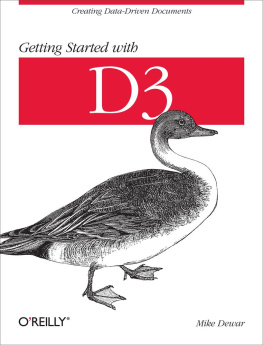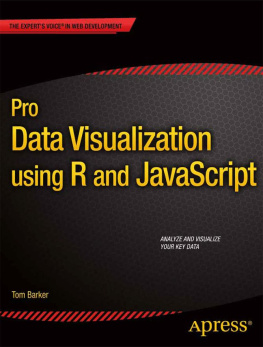Mike Dewar - Getting Started with D3
Here you can read online Mike Dewar - Getting Started with D3 full text of the book (entire story) in english for free. Download pdf and epub, get meaning, cover and reviews about this ebook. year: 2012, publisher: OReilly Media, genre: Computer. Description of the work, (preface) as well as reviews are available. Best literature library LitArk.com created for fans of good reading and offers a wide selection of genres:
Romance novel
Science fiction
Adventure
Detective
Science
History
Home and family
Prose
Art
Politics
Computer
Non-fiction
Religion
Business
Children
Humor
Choose a favorite category and find really read worthwhile books. Enjoy immersion in the world of imagination, feel the emotions of the characters or learn something new for yourself, make an fascinating discovery.
- Book:Getting Started with D3
- Author:
- Publisher:OReilly Media
- Genre:
- Year:2012
- Rating:5 / 5
- Favourites:Add to favourites
- Your mark:
Getting Started with D3: summary, description and annotation
We offer to read an annotation, description, summary or preface (depends on what the author of the book "Getting Started with D3" wrote himself). If you haven't found the necessary information about the book — write in the comments, we will try to find it.
Learn how to create beautiful, interactive, browser-based data visualizations with the D3 JavaScript library. This hands-on book shows you how to use a combination of JavaScript and SVG to build everything from simple bar charts to complex infographics. Youll learn how to use basic D3 tools by building visualizations based on real data from the New York Metropolitan Transit Authority.
Using historical tables, geographical information, and other data, youll graph bus breakdowns and accidents and the percentage of subway trains running on time, among other examples. By the end of the book, youll be prepared to build your own web-based data visualizations with D3.
- Join a dataset with elements of a webpage, and modify the elements based on the data
- Map data values onto pixels and colors with D3s scale objects
- Apply axis and line generators to simplify aspects of building visualizations
- Create a simple UI that allows users to investigate and compare data
- Use D3 transitions in your UI to animate important aspects of the data
- Get an introduction to D3 layout tools for building more sophisticated visualizations
If you can code and manipulate data, and know how to work with JavaScript and SVG, this book is for you.
Mike Dewar: author's other books
Who wrote Getting Started with D3? Find out the surname, the name of the author of the book and a list of all author's works by series.












